Yang Tian
Open Multimodal Retrieval-Augmented Factual Image Generation
Oct 26, 2025Abstract:Large Multimodal Models (LMMs) have achieved remarkable progress in generating photorealistic and prompt-aligned images, but they often produce outputs that contradict verifiable knowledge, especially when prompts involve fine-grained attributes or time-sensitive events. Conventional retrieval-augmented approaches attempt to address this issue by introducing external information, yet they are fundamentally incapable of grounding generation in accurate and evolving knowledge due to their reliance on static sources and shallow evidence integration. To bridge this gap, we introduce ORIG, an agentic open multimodal retrieval-augmented framework for Factual Image Generation (FIG), a new task that requires both visual realism and factual grounding. ORIG iteratively retrieves and filters multimodal evidence from the web and incrementally integrates the refined knowledge into enriched prompts to guide generation. To support systematic evaluation, we build FIG-Eval, a benchmark spanning ten categories across perceptual, compositional, and temporal dimensions. Experiments demonstrate that ORIG substantially improves factual consistency and overall image quality over strong baselines, highlighting the potential of open multimodal retrieval for factual image generation.
InstructVLA: Vision-Language-Action Instruction Tuning from Understanding to Manipulation
Jul 23, 2025Abstract:To operate effectively in the real world, robots must integrate multimodal reasoning with precise action generation. However, existing vision-language-action (VLA) models often sacrifice one for the other, narrow their abilities to task-specific manipulation data, and suffer catastrophic forgetting of pre-trained vision-language capabilities. To bridge this gap, we introduce InstructVLA, an end-to-end VLA model that preserves the flexible reasoning of large vision-language models (VLMs) while delivering leading manipulation performance. InstructVLA introduces a novel training paradigm, Vision-Language-Action Instruction Tuning (VLA-IT), which employs multimodal training with mixture-of-experts adaptation to jointly optimize textual reasoning and action generation on both standard VLM corpora and a curated 650K-sample VLA-IT dataset. On in-domain SimplerEnv tasks, InstructVLA achieves 30.5% improvement over SpatialVLA. To evaluate generalization, we introduce SimplerEnv-Instruct, an 80-task benchmark requiring closed-loop control and high-level instruction understanding, where it outperforms a fine-tuned OpenVLA by 92% and an action expert aided by GPT-4o by 29%. Additionally, InstructVLA surpasses baseline VLMs on multimodal tasks and exhibits inference-time scaling by leveraging textual reasoning to boost manipulation performance in both simulated and real-world settings. These results demonstrate InstructVLA's potential for bridging intuitive and steerable human-robot interaction with efficient policy learning.
The Medium Is Not the Message: Deconfounding Text Embeddings via Linear Concept Erasure
Jul 01, 2025Abstract:Embedding-based similarity metrics between text sequences can be influenced not just by the content dimensions we most care about, but can also be biased by spurious attributes like the text's source or language. These document confounders cause problems for many applications, but especially those that need to pool texts from different corpora. This paper shows that a debiasing algorithm that removes information about observed confounders from the encoder representations substantially reduces these biases at a minimal computational cost. Document similarity and clustering metrics improve across every embedding variant and task we evaluate -- often dramatically. Interestingly, performance on out-of-distribution benchmarks is not impacted, indicating that the embeddings are not otherwise degraded.
CronusVLA: Transferring Latent Motion Across Time for Multi-Frame Prediction in Manipulation
Jun 24, 2025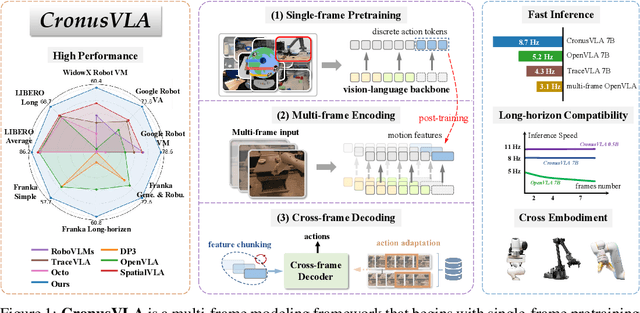
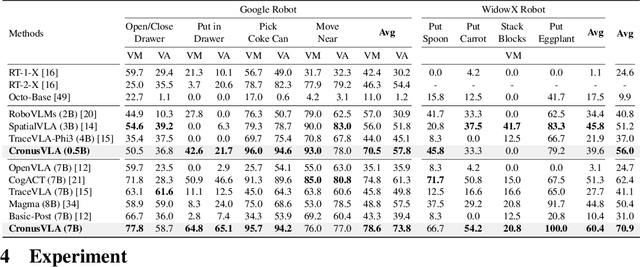
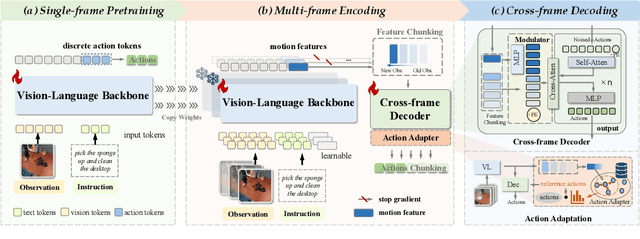
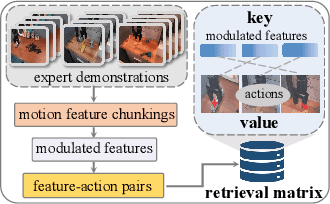
Abstract:Recent vision-language-action (VLA) models built on pretrained vision-language models (VLMs) have demonstrated strong generalization across manipulation tasks. However, they remain constrained by a single-frame observation paradigm and cannot fully benefit from the motion information offered by aggregated multi-frame historical observations, as the large vision-language backbone introduces substantial computational cost and inference latency. We propose CronusVLA, a unified framework that extends single-frame VLA models to the multi-frame paradigm through an efficient post-training stage. CronusVLA comprises three key components: (1) single-frame pretraining on large-scale embodied datasets with autoregressive action tokens prediction, which establishes an embodied vision-language foundation; (2) multi-frame encoding, adapting the prediction of vision-language backbones from discrete action tokens to motion features during post-training, and aggregating motion features from historical frames into a feature chunking; (3) cross-frame decoding, which maps the feature chunking to accurate actions via a shared decoder with cross-attention. By reducing redundant token computation and caching past motion features, CronusVLA achieves efficient inference. As an application of motion features, we further propose an action adaptation mechanism based on feature-action retrieval to improve model performance during finetuning. CronusVLA achieves state-of-the-art performance on SimplerEnv with 70.9% success rate, and 12.7% improvement over OpenVLA on LIBERO. Real-world Franka experiments also show the strong performance and robustness.
GENMANIP: LLM-driven Simulation for Generalizable Instruction-Following Manipulation
Jun 12, 2025Abstract:Robotic manipulation in real-world settings remains challenging, especially regarding robust generalization. Existing simulation platforms lack sufficient support for exploring how policies adapt to varied instructions and scenarios. Thus, they lag behind the growing interest in instruction-following foundation models like LLMs, whose adaptability is crucial yet remains underexplored in fair comparisons. To bridge this gap, we introduce GenManip, a realistic tabletop simulation platform tailored for policy generalization studies. It features an automatic pipeline via LLM-driven task-oriented scene graph to synthesize large-scale, diverse tasks using 10K annotated 3D object assets. To systematically assess generalization, we present GenManip-Bench, a benchmark of 200 scenarios refined via human-in-the-loop corrections. We evaluate two policy types: (1) modular manipulation systems integrating foundation models for perception, reasoning, and planning, and (2) end-to-end policies trained through scalable data collection. Results show that while data scaling benefits end-to-end methods, modular systems enhanced with foundation models generalize more effectively across diverse scenarios. We anticipate this platform to facilitate critical insights for advancing policy generalization in realistic conditions. Project Page: https://genmanip.axi404.top/.
LEXam: Benchmarking Legal Reasoning on 340 Law Exams
May 19, 2025

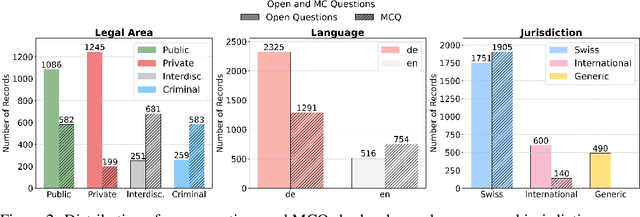
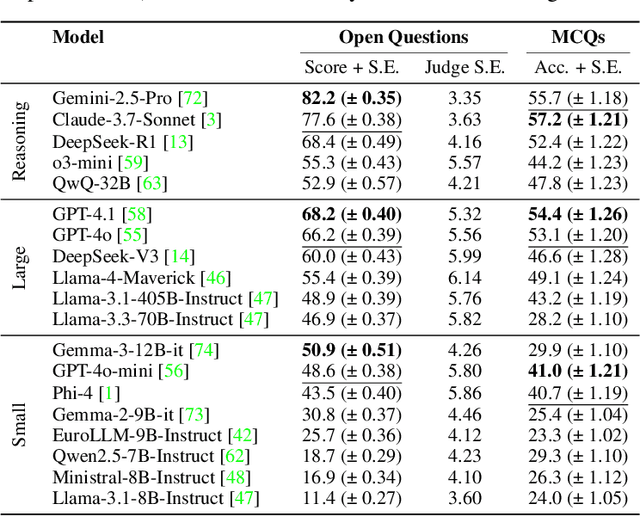
Abstract:Long-form legal reasoning remains a key challenge for large language models (LLMs) in spite of recent advances in test-time scaling. We introduce LEXam, a novel benchmark derived from 340 law exams spanning 116 law school courses across a range of subjects and degree levels. The dataset comprises 4,886 law exam questions in English and German, including 2,841 long-form, open-ended questions and 2,045 multiple-choice questions. Besides reference answers, the open questions are also accompanied by explicit guidance outlining the expected legal reasoning approach such as issue spotting, rule recall, or rule application. Our evaluation on both open-ended and multiple-choice questions present significant challenges for current LLMs; in particular, they notably struggle with open questions that require structured, multi-step legal reasoning. Moreover, our results underscore the effectiveness of the dataset in differentiating between models with varying capabilities. Adopting an LLM-as-a-Judge paradigm with rigorous human expert validation, we demonstrate how model-generated reasoning steps can be evaluated consistently and accurately. Our evaluation setup provides a scalable method to assess legal reasoning quality beyond simple accuracy metrics. Project page: https://lexam-benchmark.github.io/
Gripper Keypose and Object Pointflow as Interfaces for Bimanual Robotic Manipulation
Apr 24, 2025Abstract:Bimanual manipulation is a challenging yet crucial robotic capability, demanding precise spatial localization and versatile motion trajectories, which pose significant challenges to existing approaches. Existing approaches fall into two categories: keyframe-based strategies, which predict gripper poses in keyframes and execute them via motion planners, and continuous control methods, which estimate actions sequentially at each timestep. The keyframe-based method lacks inter-frame supervision, struggling to perform consistently or execute curved motions, while the continuous method suffers from weaker spatial perception. To address these issues, this paper introduces an end-to-end framework PPI (keyPose and Pointflow Interface), which integrates the prediction of target gripper poses and object pointflow with the continuous actions estimation. These interfaces enable the model to effectively attend to the target manipulation area, while the overall framework guides diverse and collision-free trajectories. By combining interface predictions with continuous actions estimation, PPI demonstrates superior performance in diverse bimanual manipulation tasks, providing enhanced spatial localization and satisfying flexibility in handling movement restrictions. In extensive evaluations, PPI significantly outperforms prior methods in both simulated and real-world experiments, achieving state-of-the-art performance with a +16.1% improvement on the RLBench2 simulation benchmark and an average of +27.5% gain across four challenging real-world tasks. Notably, PPI exhibits strong stability, high precision, and remarkable generalization capabilities in real-world scenarios. Project page: https://yuyinyang3y.github.io/PPI/
Attentional Graph Meta-Learning for Indoor Localization Using Extremely Sparse Fingerprints
Apr 07, 2025Abstract:Fingerprint-based indoor localization is often labor-intensive due to the need for dense grids and repeated measurements across time and space. Maintaining high localization accuracy with extremely sparse fingerprints remains a persistent challenge. Existing benchmark methods primarily rely on the measured fingerprints, while neglecting valuable spatial and environmental characteristics. In this paper, we propose a systematic integration of an Attentional Graph Neural Network (AGNN) model, capable of learning spatial adjacency relationships and aggregating information from neighboring fingerprints, and a meta-learning framework that utilizes datasets with similar environmental characteristics to enhance model training. To minimize the labor required for fingerprint collection, we introduce two novel data augmentation strategies: 1) unlabeled fingerprint augmentation using moving platforms, which enables the semi-supervised AGNN model to incorporate information from unlabeled fingerprints, and 2) synthetic labeled fingerprint augmentation through environmental digital twins, which enhances the meta-learning framework through a practical distribution alignment, which can minimize the feature discrepancy between synthetic and real-world fingerprints effectively. By integrating these novel modules, we propose the Attentional Graph Meta-Learning (AGML) model. This novel model combines the strengths of the AGNN model and the meta-learning framework to address the challenges posed by extremely sparse fingerprints. To validate our approach, we collected multiple datasets from both consumer-grade WiFi devices and professional equipment across diverse environments. Extensive experiments conducted on both synthetic and real-world datasets demonstrate that the AGML model-based localization method consistently outperforms all baseline methods using sparse fingerprints across all evaluated metrics.
MMCR: Benchmarking Cross-Source Reasoning in Scientific Papers
Mar 21, 2025



Abstract:Fully comprehending scientific papers by machines reflects a high level of Artificial General Intelligence, requiring the ability to reason across fragmented and heterogeneous sources of information, presenting a complex and practically significant challenge. While Vision-Language Models (VLMs) have made remarkable strides in various tasks, particularly those involving reasoning with evidence source from single image or text page, their ability to use cross-source information for reasoning remains an open problem. This work presents MMCR, a high-difficulty benchmark designed to evaluate VLMs' capacity for reasoning with cross-source information from scientific papers. The benchmark comprises 276 high-quality questions, meticulously annotated by humans across 7 subjects and 10 task types. Experiments with 18 VLMs demonstrate that cross-source reasoning presents a substantial challenge for existing models. Notably, even the top-performing model, GPT-4o, achieved only 48.55% overall accuracy, with only 20% accuracy in multi-table comprehension tasks, while the second-best model, Qwen2.5-VL-72B, reached 39.86% overall accuracy. Furthermore, we investigated the impact of the Chain-of-Thought (CoT) technique on cross-source reasoning and observed a detrimental effect on small models, whereas larger models demonstrated substantially enhanced performance. These results highlight the pressing need to develop VLMs capable of effectively utilizing cross-source information for reasoning.
Re$^3$Sim: Generating High-Fidelity Simulation Data via 3D-Photorealistic Real-to-Sim for Robotic Manipulation
Feb 12, 2025Abstract:Real-world data collection for robotics is costly and resource-intensive, requiring skilled operators and expensive hardware. Simulations offer a scalable alternative but often fail to achieve sim-to-real generalization due to geometric and visual gaps. To address these challenges, we propose a 3D-photorealistic real-to-sim system, namely, RE$^3$SIM, addressing geometric and visual sim-to-real gaps. RE$^3$SIM employs advanced 3D reconstruction and neural rendering techniques to faithfully recreate real-world scenarios, enabling real-time rendering of simulated cross-view cameras within a physics-based simulator. By utilizing privileged information to collect expert demonstrations efficiently in simulation, and train robot policies with imitation learning, we validate the effectiveness of the real-to-sim-to-real pipeline across various manipulation task scenarios. Notably, with only simulated data, we can achieve zero-shot sim-to-real transfer with an average success rate exceeding 58%. To push the limit of real-to-sim, we further generate a large-scale simulation dataset, demonstrating how a robust policy can be built from simulation data that generalizes across various objects. Codes and demos are available at: http://xshenhan.github.io/Re3Sim/.
 Add to Chrome
Add to Chrome Add to Firefox
Add to Firefox Add to Edge
Add to Edge